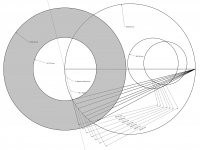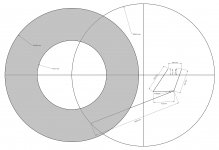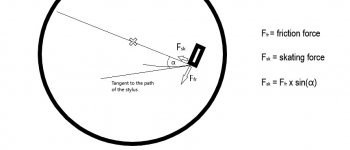Building Tangential Tracking Pivot Tonearms
Let me explain the title first. In my opinion, there won’t be Reed 5A tonearm without Doug Tuthill’s primary work here in the DIY audio forum. Therefore, he deserves credit for the creation of Reed 5A.
I have been studying Reed 5A and trying to design my own building plan. After many different versions of the design, I finally came up with the version I think has the smallest tracking errors. I would like to prompt criticisms and suggestions before I start to build. There are two things I paid a great deal of attention to. First, I concentrated in the playable area only. Please see the gray area in the diagram. Secondly, I tried to minimize the tracking errors.
The purpose to build a clone of Reed 5A is to approve that a tangential tracking pivot arm based on Birch geometry won’t skate. I intend to build a fully working arm without actual wiring. If one day, all of a sudden, I have eager to listen to this arm, I can simply wire the arm up and have a listen.
In theory, Birch geometry is not perfect. Therefore, there are some small tracking errors. As long as the tracking error exists, it means that side force exists. But in reality, such side forces are so small that they are not strong enough to cause arm skating. So, an arm based on Birch geometry won’t skate in reality. This is all I care about. For my arm, the largest tracking error is 0.1 degrees. In the diagram, the largest tracking error exists the most inner groove. If in actual use, I can align the arm so that the largest tracking error will be on the most outer groove since it is easy to play the most outer groove. Please see the diagram for tracking error analysis.
Comparing Reed 5A with my design, I think my arm has less tracking errors than Reed 5A. Of course, I can be wrong since I don’t have the data for Reed 5A. All the analyses are based on the screen catch from the video of Reed 5A.
I am going to build the arm and all the results will be posted under this thread.
Let me explain the title first. In my opinion, there won’t be Reed 5A tonearm without Doug Tuthill’s primary work here in the DIY audio forum. Therefore, he deserves credit for the creation of Reed 5A.
I have been studying Reed 5A and trying to design my own building plan. After many different versions of the design, I finally came up with the version I think has the smallest tracking errors. I would like to prompt criticisms and suggestions before I start to build. There are two things I paid a great deal of attention to. First, I concentrated in the playable area only. Please see the gray area in the diagram. Secondly, I tried to minimize the tracking errors.
The purpose to build a clone of Reed 5A is to approve that a tangential tracking pivot arm based on Birch geometry won’t skate. I intend to build a fully working arm without actual wiring. If one day, all of a sudden, I have eager to listen to this arm, I can simply wire the arm up and have a listen.
In theory, Birch geometry is not perfect. Therefore, there are some small tracking errors. As long as the tracking error exists, it means that side force exists. But in reality, such side forces are so small that they are not strong enough to cause arm skating. So, an arm based on Birch geometry won’t skate in reality. This is all I care about. For my arm, the largest tracking error is 0.1 degrees. In the diagram, the largest tracking error exists the most inner groove. If in actual use, I can align the arm so that the largest tracking error will be on the most outer groove since it is easy to play the most outer groove. Please see the diagram for tracking error analysis.
Comparing Reed 5A with my design, I think my arm has less tracking errors than Reed 5A. Of course, I can be wrong since I don’t have the data for Reed 5A. All the analyses are based on the screen catch from the video of Reed 5A.
I am going to build the arm and all the results will be posted under this thread.
Attachments
Last edited:
This will be a good thread, Jim! I look forward to the development of this project! Kudos to you giving props to Doug!
I am skeptical of the 5A being skate-free but even if the skating force were negligible without additional anti-skating device then it would still be worthy of a DIY project and perhaps will motivate other DIYers start their own journey. Your skill and patience will provide much inspiration to me and others. Cheers!
I am skeptical of the 5A being skate-free but even if the skating force were negligible without additional anti-skating device then it would still be worthy of a DIY project and perhaps will motivate other DIYers start their own journey. Your skill and patience will provide much inspiration to me and others. Cheers!
As long as the tracking error exists, it means that side force exists. But in reality, such side forces are so small that they are not strong enough to cause arm skating.
The source of the skating force is not the tracking error but the torque of the friction force exerted through the distance to the pivot.
Traditional pivoting tonearms have zero tracking error on two points but even on those points the skating force exists.

Last edited:
The source of the skating force is not the tracking error but the torque of the friction force exerted through the distance to the pivot.
Traditional pivoting tonearms have zero tracking error on two points but even on those points the skating force exists.
You are 100% right. What I said was based on the following skating diagram and it was specifically referring to Birch geometry tonearm. Even for Birch geometry arms, tracking error is not the cause of skating. But tracking error and skating must co-exist. This was why I said as long as the tracking error exists, it means that the side force exists.

Last edited:
1 pivot vs 2 pivots
When you did your test for that diagram you did it with a non-offset single fixed pivot tonearm. You moved the pivot point incrementally and charted your diagram so essentially you were doing what a servo would be doing. Don't forget all Birch style tonearm has TWO horizontal pivot points. And no matter how tangentially accurate you make it to be there is always that extra pivot to deal with which is not in line with the Thales segments, the bête noire of this whole debate. Well, your Reed 5A clone will eventually test it properly so I look forward to your finding.
What I said was based on the following skating diagram and it was specifically referring to Birch geometry tonearm.
https://flic.kr/p/2m84c86
When you did your test for that diagram you did it with a non-offset single fixed pivot tonearm. You moved the pivot point incrementally and charted your diagram so essentially you were doing what a servo would be doing. Don't forget all Birch style tonearm has TWO horizontal pivot points. And no matter how tangentially accurate you make it to be there is always that extra pivot to deal with which is not in line with the Thales segments, the bête noire of this whole debate. Well, your Reed 5A clone will eventually test it properly so I look forward to your finding.
I understand you very clearly. We all agree that a single-pivot tonearm with no offset will not skate on Thales circle. The key difference we have is for the multi-pivot tonearm with no offset. I think it makes no difference and it won't skate on Thales circle. While you think multi-pivot does make difference. A multi-pivot tonearm will skate even on Thales circle. Let's see what the test tells us.
The key difference we have is for the multi-pivot tonearm with no offset. I think it makes no difference and it won't skate on Thales circle.
But there is an offset. The moving pivot is the offset.
The key difference we have is for the multi-pivot tonearm with no offset. I think it makes no difference and it won't skate on Thales circle.
But there is an offset. The moving pivot (1B1, 1B2, 1B3) is the offset. And 1P2 is the main fixed pivot. So you can think of the black line from A3 to 1B3 as a long headshell that Hiten referred to in the other thread.

In my previous post, I added the word, offset, to avoid confusion, but it seems that I was not successful to do so.
When we say “offset”, we may mean two different things.
1, Offset angle. The meaning of offset here is the same as everyone talks about. It refers to the offset angle directly after the headshell. For this kind of offset, I have already said that it is irrelevant. This is also why I think both Conrad’s condition and the String Test can’t be used to judge if tonearms skate or not. In my previous comment here, I meant it is the offset angle directly behind the headshell.
2, Offset. I use the word, offset, to refer to the structure of a tonearm here. I am quoting my own words from Bon’s thread.
When we say “offset”, we may mean two different things.
1, Offset angle. The meaning of offset here is the same as everyone talks about. It refers to the offset angle directly after the headshell. For this kind of offset, I have already said that it is irrelevant. This is also why I think both Conrad’s condition and the String Test can’t be used to judge if tonearms skate or not. In my previous comment here, I meant it is the offset angle directly behind the headshell.
2, Offset. I use the word, offset, to refer to the structure of a tonearm here. I am quoting my own words from Bon’s thread.
In theory, I foresee a 2 pivots Birch geometry arm won’t skate. A 2 pivots Birch's arm is the same as a regular pivot arm with offset. The differences are Birch's arm has various offset angles and the offset is in the middle of the arm. However, I think further tests are needed to ensure my theoretical guess is correct. Furthermore, for an arm as Reed 5A, I don’t know for now.
This is a generalized formula for the skating force, it does not depend on the realization of the tonearm:
This is exactly what I think. The model does match my skating diagram perfectly.
it does not depend on the realization of the tonearm
On second thought, your model refers to the tonearm doesn't have an overhang. It doesn't apply to a regular tonearm that has an overhang. When, sin 90=1, i.e. at the null. Fsk is not equal to Ffr. The arm skates.
Last edited:
When, sin 90=1, i.e. at the null. Fsk is not equal to Ffr. The arm skates.
When sin (90) = 1, Fsk IS equal to Ffr. They overlap.
I But for a tonearm that has overhang, the tonearm does skate at null, ie, sin 90=1. Therefore, Fsk must not be equal to Ffr.
Yes, it will skate, because the path of the stylus will be orthogonal to the line to the spindle, i. e. the friction force will be equal to the skating force.
As predicted by my formula.
I don't know what you are talking about.
1, On the Thales circle, Reed 5A is on the Thales circle without overhang. It supposes to have no skating by their claim.
2, All regular pivot tonearms are beyond Thales circle with overhang and two nulls. They can be sin(90)=1, at null. By your model, once sin(90)=1. Fsk=Ffr. If Fsk=Ffr, does this mean there is no skating? However, all regular pivot arms skate at nulls, i.e., sin(90)=1.
All the tonearms are real. They are not imaginations.
1, On the Thales circle, Reed 5A is on the Thales circle without overhang. It supposes to have no skating by their claim.
2, All regular pivot tonearms are beyond Thales circle with overhang and two nulls. They can be sin(90)=1, at null. By your model, once sin(90)=1. Fsk=Ffr. If Fsk=Ffr, does this mean there is no skating? However, all regular pivot arms skate at nulls, i.e., sin(90)=1.
All the tonearms are real. They are not imaginations.
Last edited:
- Home
- Source & Line
- Analogue Source
- Building a Tuthill/Reed 5A Tangential Tracking Pivot Tonearm



